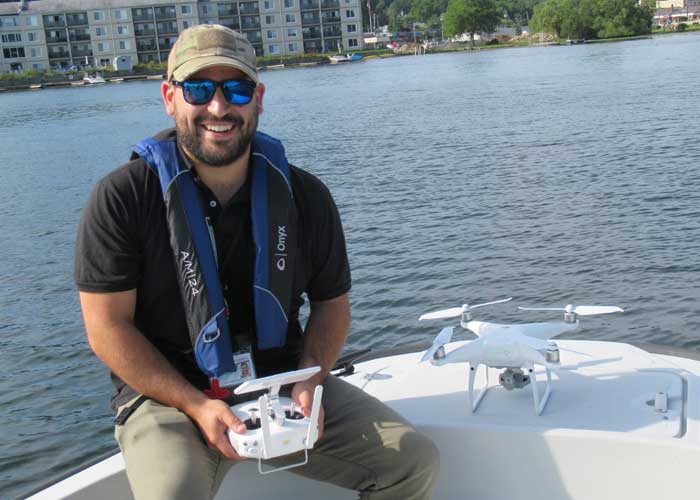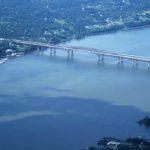CARMEL – Last year Putnam County beaches lost 529 days due to algae blooms. That constituted 27 percent of all beach closures in New York State.
This year the numbers have declined dramatically to 125 lost beach days now that the blue-green algae crisis has been monitored all summer long by representatives of the Putnam Health Department under the direction of Public Health Sanitarian Shawn Rogan who is expected to be named as director of Environmental Health Services once the re-organization of the Health Department occurs.
This summer the department’s war on blue-green algae has been assisted by a drone operated by Dan Reis, a sanitarian and assisted by Emily Olenius of Brewster, a seasonal employee.
Only a handful of lakes with public beaches experienced closures for blue-green algae this summer including Lake Carmel, Putnam Lake, Lake Casse, Long Pond, Lake Peekskill and Barger Pond, both in Putnam Valley.
Rogan, Reis and Olenius joined sheriff’s Sgt. Scott Lombardo who heads up the 14-man Sheriff’s Marine Division, and spent several hours on Lake Mahopac checking for the dangerous algae.
Rogan attributed the algae problems found in Putnam to its lake communities. “So many exist and most homes around lakes are served by septic systems. Add that to the fertilizer cared for yards and storm water run-off and blue-green algae is often the result.”
Blue-green algae results from nutrients in the water such as nitrogen and phosphorus that feed the algae. Rogan said the increase of incidents is a direct result of “impacts to the water bodies from nutrients being deposited in area lakes from failing septic systems, run off from stormwater and fertilizers people use in their yards which are all contributing factors to the epidemic.”
Blue-green algae can result in various health concerns including skin irritations. “If a child ingests the water, he or she may develop serious cases of vomiting or diarrhea. There is also inhalation concerns related to blue-green algae. A person seated on the beach may be exposed to wave action from a motor boat or even the wind. These aerosolized toxins result in inhalation concerns,” Rogan said.
Long Pond in Mahopac experienced its first blue-green algae bloom a week and a half ago at the Sycamore Park beach. Rogan said the Rock Hill Girl Scout Camp turned out to be negative for any algae blooms. The staff also checked the Long Pond Association beach and found a bloom. Warnings were immediately sent to the 60 residents who regularly use the beach each summer.
On the western side of the county, Rogan said no algae blooms have been reported on Lake Oscawana in Putnam Valley. “The sheriff’s department regularly patrols the lake and deputies have become our extended eyes by monitoring the situation. There is nothing like an extra set of eyes on the water.”
Rogan also wants the public to become involved. “If you see something suspicious, call us. Our staff hopes to sponsor an educational seminar in February or March of 2020 specifically for recreational users. Identification is the most important aspect. If you don’t know about blue-green algae and swim in it, you won’t know how to avoid it. Early identification, reporting to the health department and avoidance are the best ways to keep one’s family safe.”
Meanwhile, Commissioner of Health Dr. Michael Nesheiwat reminded the public that potential health impacts of being exposed to an algae bloom include, irritation of the skin, eyes, nose, throat and respiratory tract while swallowing water containing an algae bloom often results in nausea, vomiting and diarrhea.
“When a person is exposed to a blue-green algae bloom, he or she must rinse off with clean water immediately while considering medical attention for any symptoms associated with the exposure including breathing difficulties,” said Dr. Nesheiwat.
Rogan also reminded pet owners to be concerned about Fido entering water containing blue-green algae since dogs and other mammals can become ill when exposed to the blooms that may look like streaks, spilled paint, pea soup, floating clumps or dots.








